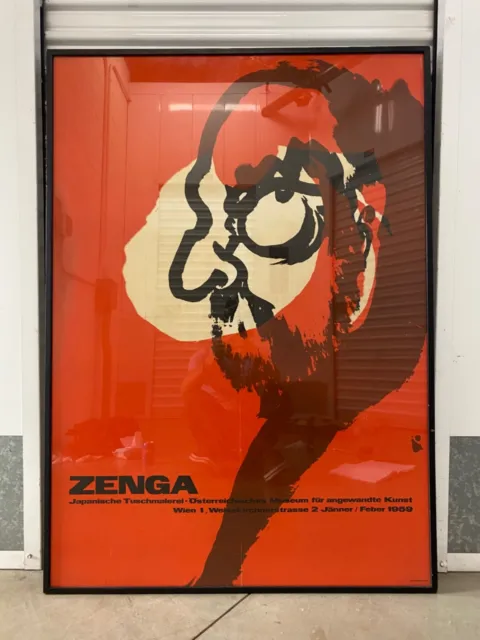🔥 RARE Vintage German Modern Expressionist Exhibition Poster, Hans FABIGAN 1959
Died : 1975 Known for : Painting Hans Fabigan (1901 - 1975) is known for Painting.
Hans Fabigan. 1901-1975. Born: Vienna, Austria
1901-1975. Born: Vienna, Austria. Graphic designer, illustrator, cartoonist and fashion designer. Studied at the Graphic Institute in Vienna. Award-winning poster designer
Hans Fabigan (14 June 1901 - 23 February 1975 ) was an Austrian painter and poster artist . In 1961 he received the Prize of the City of Vienna for Fine Arts (category Applied Arts).
Fabigan attended the Vienna Graphic Teaching and Research Institute . His most successful period was the 1950s, when he designed many posters and also taught at the Art School of the City of Vienna. Fabigan is buried in an honorary grave at Vienna's Central Cemetery (Group 40).
Zenga: A Brief History
By Yukio Lippit
Introduction
The term “Zenga” (literally “Zen painting”) designates paintings and calligraphies primarily by Japanese Zen monk-painters active from the Edo period (1615–1868) through the modern era. For the most part, Zenga works render deities and patriarchs from the Zen Buddhist pantheon or inscriptions of Zen sayings in ways that are direct, bold, gestural, and communicative, but they can also include depictions of folk deities, themes in popular culture, and allegorical paintings reflecting Zen teachings. In their simplicity and often-invoked “cartoonish” quality, these works can be distinguished from the Zen arts of earlier eras, which were invariably more specialized, drew heavily upon Chinese modes of representation, and intended for elite audiences.1
As an art historical category, however, Zenga is of fairly recent vintage, having become widespread only in the postwar era. As such, its place within histories of Japanese culture remains ambiguous. This unsettledness stems from an increasing awareness of the specific postwar conditions worldwide within which Zenga achieved international acclaim, as well as the traditional exclusion of Zenga painters from the art historical canon in Japan itself. This essay takes Zenga’s ambiguity as a starting point and works backward chronologically in an attempt to further consider several historical aspects of this corpus of visual material: its emergence as an artistic category in the modern era, the formation of a Zenga canon, and the most salient visual qualities of works by Edo monk-painters.
Postwar Zenga
To understand the discursive space occupied by Zenga today, it is fruitful to trace the rise of Zenga as a phenomenon in the West during the 1950s and 1960s. This phenomenon played out in numerous exhibitions and publications and was centered around the embrace of two Edo-period monk-painters in particular: Hakuin Ekaku (1685–1768) and Sengai Gibon (1750–1837). In 1956, for example, an exhibition of twenty-three works by Sengai from Idemitsu Sazō’s (1885–1981) collection was held as part of a Japanese cultural fair in Oakland, California.2
As a term, “Zenga” appears to have been coined by the German businessman Kurt Brasch (1907–1974) on the occasion of Malerei des Zen-Buddhismus in Japan, a major exhibition of Edo-period Zen monk-painters that toured Europe in 1959–60. By all accounts, this exhibition was a major success and established a broad foundation for Zenga’s popularity in the West. From January of 1959, over the course of a year, the exhibition traveled to seven European cities: Vienna, Cologne, Bern, Copenhagen, Berlin, Milan, and Rome. Then in 1961, inspired by the success of Brasch’s Zen exhibition, a second show focusing on eighty works by Sengai titled Exposition itinérante de Sengai en Europe opened in Rome and traveled to some fourteen European cities over three years. The art historian Okamura Yoshiko has traced the high acclaim with which both exhibitions were received through newspaper accounts and exhibition reviews, and how they rapidly led to even larger state-sponsored exhibitions.3 In 1963, for example, the French and Japanese governments co-organized the show L’au-delà dans l’art japonais, primarily through the initiative of the French Minister of Cultural Affairs André Malraux (1901–1976).4 Although the exhibition was meant to survey the religious art of Japan, 124 of the 201 total display objects were of Zenga. In 1965 German government officials followed by organizing Japanische Kunst des späten Zen at the Akademie der Künste in Berlin, which included thirty-four Zenga works from the collection of Hosokawa Moritatsu (1883–1970).
Thus, the years 1959 to 1965 witnessed a total of twenty-four exhibits of Zenga artworks in museums and cultural institutions around Europe. Okamura goes so far as to refer to this burst of activity as a “second wave” of Japonisme. As Okamura notes, Brasch was clearly the figure most responsible for initiating the Zenga boom in Europe. His publications included a German book on Hakuin, Hakuin und die Zen-Malerei (1957), that predated the Zenga exhibition, another German publication titled Zenga, Zen-Malerei (1961) that appeared soon after the European traveling show, and the Japanese book Zenga (1962), which remains influential to this day.
Brasch also played a central role in the formation of a Zenga canon. This canon now centers on figures who were accorded special attention in Brasch’s writings: Hakuin and Sengai, along with Hakuin’s lineage of disciples, especially Hakuin’s immediate followers Tōrei Enji (1721–1792) and Suiō Genro (1717–1789). From this core of monk-painters, Brasch worked backward to find predecessors who appeared, at least visually, to anticipate Hakuin’s artistry in the seventeenth century, resulting in a genealogy of Zenga that extended back to early years of the Edo period (1615–1868). The contents of the 1959–60 European Zenga exhibition provide a snapshot of the Zenga canon. Consisting of seventy-two works in all, it included thirty-eight by Hakuin, twelve by Sengai, six by Tōrei, three by Suiō, five by the monk Fūgai Ekun (1568–1654), and one each by his slightly later contemporaries Takuan Sōhō (1573–1645), Ungo Kiyō (1583–1659), and Isshi Bunshu (1608–1646). The unsettled state of this genealogy is reflected in Brasch’s statement that he was unsure about the inclusion of Takuan and Isshi, whose paintings he felt focused more on “form” and were therefore more suitable as “tea hangings.”5
Zenga in Modern Japan
Numerous studies have addressed the historical and ideological reasons for the popularity of Zenga as a category of Japanese painting in the postwar West.6 The Cold War provided a favorable ideological context for cultural exchange between Japan and the West. The writings of D. T. Suzuki were crucial not only to the popularization of Zen Buddhism in the English-language sphere but also to Zen’s reformulation as a modern religion that could be articulated through the languages of philosophy and psychology. And the rise of Abstract Expressionism allowed the visual qualities of paintings and calligraphies by Zen monk-painters to be conceptualized as modern and abstract.7 The convergence of these developments were crucial to the establishment and embrace of Zenga as a Japanese “tradition.”
It is also the case, however, that many of the artists who would become associated with Zenga and its canon were already well established among collectors and cultural figures in Japan during the early decades of the twentieth century. Indeed, most of the early exhibitions of Zenga in the West mentioned earlier drew from private collections amassed by industrialists and government officials in the early twentieth century, most notably those by Hosokawa Moritatsu and Idemitsu Sazō. Their embrace of Edo monk-painters such as Hakuin and Sengai can be understood as filling a spiritual void that emerged with Japan’s transition to modernity. In considering the role of Zen as a form of therapeutic spiritualism in late nineteenth- and early twentieth-century Japan, the efforts of Shaku Sōen (1860–1919), the Meiji-era abbot of Engakuji monastery in Kamakura, loom especially large. Sōen may be best known today as the teacher of D. T. Suzuki, but his own career paralleled the vagaries of Zen Buddhism at the turn of the century, and he played as important a role as anyone in reforming Zen for the modern era, as well as in building a foundation for its overseas reception.8
Sōen was also among the earliest ordained Zen priests to attend university, in this case Keiō University, where he was mentored by the prominent educator Fukuzawa Yukichi (1835–1901) and the politician Yamaoka Tesshū (1836–1888). He then embarked upon a three-year stay in Ceylon (modern-day Sri Lanka) to study the Pali language and early Buddhist sutras, and upon his return became abbot of the renowned monastery Engakuji in Kamakura at the age of thirty-three. Sōen’s lecture at the World’s Parliament of Religions in Chicago in 1893 represents the first-ever exposition of Zen Buddhism in the English-language sphere.9 There, he met editor and philosopher Paul Carus (1852–1919), who was much taken with Sōen’s lecture and asked for help in translating Buddhist texts into English. Sōen sent D. T. Suzuki to help Carus with his translations, thus preparing the way for Suzuki’s later career as a prolific Zen author.10 From then onward, Sōen’s reputation grew far and wide. The American patron and Buddhist practitioner Ida Russell even came to study with him, and he met President Theodore Roosevelt in Washington, D.C., during a world tour.
In Japan, Sōen’s disciples encompassed luminaries in politics, business, and culture. Aside from D. T. Suzuki, they included the politicians Tokugawa Yoshihisa (1884–1922), Matsudaira Naoaki (1865–1940), and Prime Minister Yamaguchi Osachi (1870–1931); General Maeda Toshinari (1885–1942); the industrialist Noda Utarō (1853–1927); the educator Isawa Shūji (1851–1917); and Natsume Sōseki (1867–1916), Japan’s most renowned modern novelist. Sōen’s prolific writings, range of activities, and broad array of disciples both shaped and reflected Zen’s reformulation as a modern religion during the late nineteenth and early twentieth centuries. Furthermore, Sōen himself was an accomplished painter and calligrapher who used the brush arts to convey his teachings and mediate his relationships with monks and patrons. In this regard, his career forms an important parallel to contemporaries such as Nantembō (1839–1925, see below), who perpetuated the practices of Edo-period Zen monk-painters in the tradition of Hakuin.
Most important, Sōen’s activities provide an important framework within which to understand the rise of Japanese interest in Zenga. Indeed, the decades after Sōen established himself as abbot at Engakuji witnessed the assemblage of the earliest collections of Hakuin and Sengai, mostly by prominent industrialists and cultural figures. Thus, the Osaka businessman Yamamoto Hatsujirō (1887–1951) amassed, alongside works by the modern oil painter Saeki Yūzō, a notable assemblage of Hakuin works by the 1930s; it was at Yamamoto’s residence that Kurt Brasch first encountered Hakuin’s paintings. Literary luminaries such as Mushanokōji Saneatsu (1885–1976) and Okamoto Kanoko (1889–1939) wrote essays about his works.11
The most notable among Hakuin collectors, however, was Hosokawa Moritatsu, the head of a former daimyo house and a prominent politician who became one of the foremost art collectors of his day. According to his own account, Hosokawa’s collecting began in his teens through his encounter with Hakuin. As a sickly child, he had read Hakuin’s Idle Talk on a Night Boat (Yasen kanna, in Japanese), which inspired his practice of Zen and led to the recovery of his health.12 This experience, in turn, engendered his devotion to the Edo-period Zen monk, and Hosokawa is said to have amassed more than a thousand of his scrolls.13
Collectors of Sengai were equally abundant, and Sengai’s close association with Shōfukuji monastery in Hakata, famous as the first Zen monastery established in Japan, made him a regional favorite in Kyushu. During the early years of the twentieth century, Sengai’s popularity was bolstered by Shōfukuji’s fifteenth abbot, Tōkō Genjō (1876–1948), who began “The Society to Preserve Works by Priest Sengai” (Sengai oshō iseki hozonkai). Members of this group, such as the famous confectioner Ishimura Zen’yū (1908–1979) and the archaeologist Nakayama Morihiko (1867–1957), amassed notable collections.14 The economist Awakawa Kōichi (1902–1977) became both a noted collector and an author on Sengai, publishing Sengai of Hakata (Hakata no Sengai) in 1933 and The Paintings of the Priest Sengai (Sō Sengai no kaiga) in 1935. In the postwar period, Awakawa gained further renown for his paintings in the Zenga tradition, as well as for an English-language book on Sengai.15 The most famous collector of Sengai, however, is undoubtedly Idemitsu Sazō (1885–1981), a successful industrialist and the founder of Idemitsu Shōkai in 1911 (forerunner of Idemitsu Kōsan, Ltd.). Hailing from Akama village in Kyushu’s Fukuoka Prefecture, Idemitsu was also drawn to the regional legacy of Sengai as a Hakata-based luminary and is said to have begun his collection after encountering a Sengai painting in a Fukuoka antiquities shop at the age of nineteen. Idemitsu would end up amassing more than a thousand of Sengai’s works and was instrumental in helping to organize early postwar exhibitions of the artist in Europe and the United States.16
Hakuin
It is worth considering at greater length why Hakuin and Sengai garnered so much admiration and became the central figures around which the Zenga canon was formed. Although Zenga was an artistic category that responded to modern concerns, it was ultimately the qualities of Hakuin’s and Sengai’s works that enabled it to do so in such a direct manner.
Hakuin Ekaku (1685–1768) is commonly understood as the figure most responsible for leading the revival of the Rinzai School of Zen during the Edo period, suggesting the reach of his fame and influence. His writings include texts that are still extensively studied today, and his reform of Zen training has influenced the methods by which contemporary monks train in the Rinzai School.17 Painting and calligraphy played an important role in the propagation of Hakuin’s teachings, and he is estimated to have created some ten thousand paintings and calligraphies from his forties onward, of which more than five thousand survive.18 The subject matter of this corpus is wide-ranging and includes Buddhist deities, Zen patriarchs, indigenous kami deities, folk deities, and historical figures, as well as landscapes, animals, Zen implements, and myriad allegorical works.
Hakuin’s approach to the brush arts can be attributed to the convergence of several historical factors. The first is the expanding influence of Obaku Zen, a school of Zen Buddhism originating in southeastern China, during Hakuin’s lifetime. Although the Obaku sect had arrived in Japan well before Hakuin’s birth with the emigration of the monk Yinyuan Longqi (1592–1673) in 1654, its religious and cultural influence unfolded over many decades, especially in regions beyond Japan’s urban centers.19
The presence of Obaku Zen in Japan shaped Hakuin’s religious outlook and artistic practice in at least two important ways. The first was its role in exacerbating the perception that Japan’s traditional Rinzai Zen establishment was in decline. Because Obaku hailed from the same Rinzai (Linji, in Chinese) Zen lineage, it was viewed by some as representing a more authentic transmission of this lineage than claimed by Japan’s Rinzai monastic communities. Indeed, during the eighteenth century, the most prestigious Rinzai monasteries in Kyoto, such as Daitokuji, Myōshinji, and the five metropolitan monasteries collectively known as the “Five Mountains” (Gozan), appear to have been experiencing a crisis of legitimacy.20 Hakuin’s home temple of Shōinji in the city of Hara (present-day Numazu city, Shizuoka Prefecture) was a branch temple of the Myōshinji School, and he must have been keenly aware of the need for reform within the Rinzai sect.
Another way in which the presence of Obaku Zen shaped Hakuin’s activities was in terms of cultural practice. Many of Hakuin’s earliest surviving calligraphies, which mostly date to his late forties and early fifties, are now understood to reflect the strong influence of Obaku Zen models. Some of Hakuin’s best-known painting subjects, such as One Hundred “Kotobuki” (Longevity), are derived directly from paintings circulating in the Obaku sphere.21 And at least one of his layman disciples, the literati painter Ike no Taiga (1723–1776, see below), had close ties to the monastic community at Manpukuji, the headquarters of the Obaku sect in Japan, located in the city of Uji south of Kyoto. Although Hakuin is often seen as an amateur artist, his work in fact bears the imprint of the most advanced cultural practices in Japan at the time.
A second factor shaping Hakuin’s religious and artistic output was the inexorable spread of print culture during the eighteenth century, which enabled the dissemination of Hakuin’s teachings through published lectures and writings. Even though the texts and “recorded sayings” (goroku) of Zen monks had for centuries been published within temple communities, in the case of Hakuin, his writings were distributed by commercial publishers based in urban centers. Along with his own recorded sayings titled Poison Blossoms from Thorn Thickets (Keisō dokuzui, 1767), he published numerous vernacular writings in the kana syllabary, which helped to expand his audience and allowed him to achieve widespread fame during his lifetime. Hakuin often delivered lectures (teishō) on his own publications, presupposing a knowledge of his writings among his audiences.22
Print culture played a more subtle role in the evolution of the monk-painter’s artistry. As a late-blooming painter who began creating pictures in earnest from his sixties onward, and who never had the benefit of formal training, Hakuin appears to have taken pains to find sources and models from illustrated books. This sourcing is reflected, for example, in his reliance upon pictorial models of the earlier poet-painter Hanabusa Itchō (1652–1724). As recently demonstrated by the art historian Mabuchi Miho, Hakuin modeled a considerable number of his painting themes upon works by Itchō, which he encountered through publications such as Ōoka Shunboku’s A Garden of Celebrated Chinese and Japanese Paintings (Wakan meigaen, 1750).23 Furthermore, Hakuin’s paintings reflect an awareness of the strategies of playful framing and juxtaposition (mitate or yatsushi) employed by the contemporary print designer Suzuki Harunobu (c. 1725–1770).24 As such resonances strongly suggest, Hakuin’s Zenga participated in the urban visual culture of the mid-Edo period far more than previously assumed.
A third historical factor inflecting Hakuin’s artistic output was the monk’s relationship to social protest during the eighteenth century. Over the course of the monk’s long career, the corruption of daimyo lords and other Tokugawa elites gave rise to increasingly widespread anger among commoners. This corruption is addressed directly in one of Hakuin’s sermons titled Raspberries (Hebi ichigo), which was published in 1754 and takes the form of a letter addressed to the lord of Okayama domain, Ikeda Tsugumasa (1702–1776). Because the sermon severely criticized the wasteful extravagance of the alternate attendance system (sankin kōtai) by which daimyo were mandated to reside every other year in Edo, it was banned by the Tokugawa authorities.25 This criticism was not isolated; a recent study by the historian Takahashi Satoshi highlights the degree to which the corruption of the ruling elite was addressed both directly and indirectly in Hakuin’s lectures and writings.26 Takahashi painstakingly demonstrates the ways in which Hakuin was involved in social protest movements of his day, including his remarkable role in a peasant uprising (hyakushō ikki) during the early to mid-1760s in the Ojima domain near his hometown of Hara (Suruga Province).27 A number of his paintings mock daimyo processions, or can be read as parables admonishing daimyo corruption.28 Indeed, the populism of Hakuin’s Zen teachings was charged by the immediacy and urgency with which it addressed contemporary social justice, and in some ways his rise is more akin to the phenomenon of new Tokugawa popular religions such as Shingaku than to traditional Zen Buddhism.29 In this way, the impact of Obaku Zen, print culture, and social protest movements converged to shape Hakuin’s approach to and use of the brush arts.
In visual and thematic terms, how did Hakuin’s paintings differ from traditional paintings of Zen subject matter of the Muromachi period? There are a number of ways to answer this question. The first is to observe that while Hakuin perpetuated many of the painting subjects of the Zen canon, in particular Zen patriarchs and eccentrics, he portrayed them with exaggerated features that rendered them akin to folk art. A good example is Giant Daruma, a well-known example of Hakuin’s work in the Gitter-Yelen Collection. Bust portraits of Daruma (or Bodhidharma) were common in medieval Japan and followed an established pattern in which the Indian patriarch of Zen Buddhism was rendered mostly in three-quarter profile, with abbreviated brushwork and bulging eyes. Details such as large ears and an abundance of facial and body hair were also common. Hakuin’s portrayal includes all of the elements of this template, but renders them with greater exaggeration or intensity. Daruma’s eyes, which are meant to convey concentration and meditation, are even larger than the norm, and his pupils look up directly at the inscription. The brushwork here is thick, swiftly executed, and abbreviated; the lines of the robe embed the Japanese character for “mind” (kokoro or shin), a primary theme in Hakuin’s Zenga as the source of all illusion.
Second, Hakuin’s paintings tend to position traditional Zen figures in novel situations. In this regard, a favorite subject of his was Hotei (Budai, in Chinese), the portly Chinese Zen (Chan) priest who was prone to wander the villages of the Jiangnan region clothed as a vagabond, carrying all of his positions in a burlap sack hanging from a pole. Although traditional paintings of Hotei rendered the figure in a relatively limited number of guises—mostly sleeping, laughing, playing with children, or pointing at the moon—Hakuin mobilized the priest in ways that were unprecedented.30 Take, for example, Running Hotei in the Gitter-Yelen Collection. Here, the priest is shown running at full sprint, but instead of his familiar sack he is carrying a large mallet, which is mentioned in the accompanying inscription:
What a heavy mallet—
It will be the death of me!
Because a mallet is used to pound rice, a symbol of wealth, the inscription appears to be commenting upon the uncertain spiritual results of blindly racing to accumulate wealth. Hotei has been cast as a stand-in for an urban commoner consumed with secular concerns, a kind of Everyman pursuing worldly goals. Yoshizawa Katsuhiro likens Hotei to an “action hero” dynamically embodying various roles that convey religious teachings in Hakuin’s Zen world.31
Third, Hakuin greatly expanded the traditional repertoire of Zen painting and calligraphy to include more folk deities, popular themes, Confucian maxims, and auspicious subjects that appealed to the sensibilities of commoners. A good example from the Gitter-Yelen Collection is Virtue, a powerful calligraphic work that inscribes in large scale the character for “virtue” (toku) in its bottom half. This scroll was undoubtedly intended for a merchant, one of many who gathered around Hakuin as lay disciples. The inscription above records a passage from the Chinese literatus Sima Guang (1018–1086) that reads like an admonition for merchants who hope to maintain the prosperity of their family lineage:
If you pile up money for your descendants,
they will be sure to waste it;
If you collect books for them,
they will probably not read a word.
It is better to pile up secret virtue—
such a legacy will last a long, long time.32
Two further aspects of Hakuin’s oeuvre are particularly important to understanding his innovative approach to the pictorialization of Zen themes. One is the prevalence of allegorical painting in his oeuvre. Hakuin was fond of using allegories and parables in his lectures to illustrate Buddhist truths, and many of his paintings can be understood as extensions into the visual realm of the rhetorical strategies he adopted at the podium. Two Blind Men Crossing a Log Bridge from the Gitter-Yelen Collection embodies well this penchant. As its title suggests, this singular work depicts two blind men with staves uncertainly making their way across a bridge extending above a body of water. Only two tones of ink are employed to render a simple scene in which all of the elements are highly abbreviated, in particular the log bridge, which consists of a single, bold, and swiftly executed brushstroke that extends laterally across the pictorial surface. An inscription in the upper left reads “In both spiritual training and dealing with the world, keep in mind the example of blind men crossing a log bridge” (as translated by John Stevens), suggesting the common metaphor of secular life as a near shore and enlightenment as a far shore separated by a body of water. The inscription urges viewers to understand that the path toward spiritual awakening is similar to that of blind men attempting to cross a log bridge spanning the two shores.
A final distinguishing aspect of Hakuin’s paintings lies in the unique nature of his inscriptions, most notably the manner in which they function both graphically and orally. Hakuin often embeds his calligraphy in complex ways into the structure of his works, distributing his inscriptions in different spaces and motifs within the surface, ranging from cartoon bubbles to paintings-within-paintings. Similarly, he imbues his texts with different “voices” that borrow from myriad forms of speech or oral performance. Seven Gods of Good Fortune in the Gitter-Yelen Collection offers a compelling example. This work depicts a traditional grouping of auspicious deities that were collectively associated with good fortune: Clockwise from the top left, they are Ebisu, the god of wealth, holding a fish; Benzaiten, playing the flute, the goddess of art, music, and love; Daikoku, the god of prosperity, beating his mallet; Jurojin, the god of longevity, with red headgear and reading a text; Fukurokuju, the good of good fortune, reading the score and keeping time with his fan; the aforementioned Hotei, this time appearing as a god of happiness, using his white burlap sack as a drum; and, in the center, Shōki (Zhongkui, in Chinese), a Chinese demon queller who became a popular Japanese deity associated with apotropaic functions such as the warding off of illness and evil spirits. Only the inclusion of Shōki here deviates from standard groupings of the Seven Gods of Good Fortune, which typically include the warrior god Bishamonten instead. It is likely that this painting includes Shōki because he was associated with New Year’s pictures, indicating that this painting was a commission or gift to celebrate the start of a new year.33
There are two accompanying inscriptions in different spaces within the picture. One, prominently placed in the upper right, states as follows:
If you are loyal to your lord and filial to your parents
You will receive my straw raincoat, straw hat, magic mallet, and bag.
Meanwhile, the second inscription is embedded in the libretto spread in front of Fukurokuju in the lower left, which reads:
Shōki hides his sword under the eaves,
And stealthily, stealthily guards the palace.
In keeping with other Confucian-themed paintings and calligraphies by Hakuin, the first inscription emphasizes the virtue of filial piety. It has little to do with the teachings of Zen Buddhism, emphasizing instead the traditional values of warrior and commoner households in Edo-period Japan. The second inscription, meanwhile, emphasizes a different dimension of the New Year’s picture, in which Shōki serves an apotropaic function and ensures protection of the household (the “palace”) from evil spirits and calamity during the year to come.
Just as important as the graphic distribution of the inscriptions, however, are the different modalities of voice or utterance they embody. The words at upper right, as a record of Hakuin’s writing, can straightforwardly be understood as a reflection of Hakuin’s own voice.34 The words at lower left, however, should be understood as being chanted in the lilt of a raconteur accompanying a boisterous musical ensemble. Indeed, the words embedded in the painting are taken directly from the libretto of the Noh play Shōki, although this scene could equally invoke the ebullience of New Year’s ceremonial dances at Shinto shrines known as kagura, which also featured Shōki the demon queller in a prominent role. Here, the ensemble includes Benzaiten’s flute, the drumming of both Hotei and Daikoku, and perhaps the chanting of Jurōjin along with Fukurokuju. Shōki, in the middle, dances in an amusingly awkward and zombie-like manner to the merriment generated by his companions. This second inscription, therefore, is utterly contrastive to the first; it is sung instead of said, a merriment instead of an admonishment.
Within Hakuin’s oeuvre, Seven Gods of Good Fortune is not an isolated instance. The monk-painter was fond of embedding different forms of orality into his paintings, including popular tunes, local dialect, vernacular phrases, and children’s songs. Their inclusion diversified the rhythmic profile of a work, while rendering it more multisensorial and familiar to readers by invoking the idiolects of daily life. Although Yoshizawa has termed this approach a form of intertextuality, it might be more meaningfully grasped through the literary scholar Mikhail Bakhtin’s concept of heteroglossia. According to Bakhtin, heteroglossia designates the coexistence of various modalities of speech within a single language that serves to construct a world in which each distinct type of language reflects different values and social perspectives.35 Heteroglossia as a literary technique is closely associated with the rise of the novel, which constructs a fictional world through a multitude of such forms of language. Similarly, Hakuin evokes through his inscriptions a dynamic, multivocal world in which different aspects of Edo society coexist within the same picture. They manage to generate through an economy of means a rich fictive world of their own, animated with Zen ideas and full of immediacy to viewers.
Sengai
The other monk-painter at the heart of the Zenga canon is Sengai Gibon, who lived many generations after Hakuin and who similarly accorded a significant role to paintings and calligraphies in his religious practice. Although Sengai served for many years as abbot of Shōfukuji monastery in Fukuoka, it was during the quarter century or so after he stepped down from the abbacy and led a cloistered life that most of his prolific output was created.
Like Hakuin, Sengai mixed traditional Zen themes with a dizzying variety of subjects drawn from popular culture and daily life, rendered in highly abbreviated and purposefully awkward brushwork. Otherwise, however, his artistic output differed from that of his predecessor in significant ways. Whereas Hakuin’s oeuvre is filled with parables and allegories, and invariably strikes a serious tone, Sengai’s brims with wordplay and irony, and conveys a humorous mood.36 In terms of pictorial style, furthermore, the latter’s painting is even more abbreviated and sketchy than the former’s and lacks the intricate details, descriptive brushwork, and coloration occasionally witnessed in Hakuin’s pictures.
These differences can be attributed to a number of factors. Whereas Hakuin appears to have traveled frequently and developed networks of patrons and disciples throughout Japan’s main island, Sengai seems to have been more rooted in the local communities in and around the port city of Hakata. Sengai thus became far more identified with his regional roots and appears to have interacted with others as cultural companions as opposed to within the structure of a master-disciple relationship. His paintings bear the imprint of horizontal as opposed to vertical relationships, with an accordingly lighter and more buoyant atmosphere. In this regard, Sengai’s painting practice might be compared to haiga (paintings that accompanied haiku poetry), an idiom that by the late Edo period was familiar to large swathes of the population and with which his painting shares visual affinities.
A second distinguishing factor is the influence of literati painting on Sengai. During Hakuin’s active years as a painter, Japanese literati painting, or nanga, was still in its early stages, and Hakuin’s painting bears little relation to the painting practices of East Asian literati. By Sengai’s time, however, nanga was an established tradition boasting many generations of practitioners, and the monk-painter was known to have interacted with literati painters. Thus, Sengai’s painting is shaped by the patterns of pictorial awkwardness common to Edo-period nanga painters. Indeed, Sengai adopted a painterly philosophy known as “no-method” (muhō), a counterintuitive approach to painting with a long pedigree among East Asian literati painters, including Shitao (1642–1707) and Urakami Gyokudō (1745–1820). “No method” signaled a purposefully undercrafted approach to art-making, a form of deskilling that in the case of Sengai manifested itself in scratchy, awkward brushwork that nevertheless uncannily captured the form and spirit of its motifs.37
These qualities of lightness and awkwardness are well captured in Hotei Waking from a Nap in the Gitter-Yelen Collection. The work represents a playful variation on traditional renderings of the Zen priest Hotei in several ways. Whereas one traditional manner of depicting Hotei was in deep slumber, here he awakens. The inscription, furthermore, likens the Zen exemplar to Confucius:
What a pleasant nap—I dreamt I was the Duke of Zhou!
The Duke of Zhou was the model of the ideal statesman in ancient China and was admired by Confucius, who once stated that he dreamt that he was the Duke. One day, however, Confucius stated that he had become the Duke of Zhou, and no longer needed to dream of him. Whereas Confucius uses this episode as a way of preaching self-cultivation, Sengai playfully applies it to Zen enlightenment through the portly figure of Hotei.38
The Zenga Canon
While Hakuin and Sengai were the unambiguous focal point of modern Zenga collections, Hakuin’s predecessors and followers would also be recognized as members of the Zenga School. When determining the object list of the 1959–60 European Zenga exhibition, Brasch and his fellow organizers worked backward from Hakuin in an attempt to discern Hakuin-esque traits in works by earlier monk-painters. This phenomenon might ultimately be likened to Jorge Luis Borges’s seemingly impossible proposition that Franz Kafka influenced the writers who preceded him. As Borges states, “Each writer creates his precursors. His work modifies our conception of the past, as it will modify the future”39 —words that apply unerringly to the way Hakuin has shaped our understanding of painting history before him.
There is reason to believe that Hakuin did indeed seem to follow the precedent of earlier figures. This is most notable in the case of Fūgai Ekun (1568–1654), a somewhat opaque monk-painter active during the late sixteenth and early seventeenth century. Some of Hakuin’s Daruma paintings bear a close resemblance to Ekun’s and may initially have relied upon them as a template.40 Similarly, the calligraphy of Chinese Zen priests at Manpukuji, the headquarters of the Obaku Zen sect in Japan, such as Obaku Sokuhi, appear to have shaped the evolution of Hakuin’s calligraphy.41 Ultimately, however, Hakuin’s “predecessors” came to include mostly unrelated figures such as Shōkadō Shōjō (1584–1639), who, although a Zen monk, was better known in cultural history as a tea practitioner, and Konoe Nobutada (1565–1614), a nobleman renowned for his calligraphy.
During the Edo period, none of Hakuin’s followers ever achieved the renown of Hakuin, but they continued his practice of using painting to mediate relations with patrons and disciples. Perhaps the two best known are Hakuin’s immediate successors Tōrei Enji (1721–1792) and Suiō Genro (1716–1789). Tōrei is admired for his single-column calligraphy and ensō or “Zen circles”, reflecting an inky, dynamic, and somewhat unstructured approach to artful writing. Suiō, the official successor as abbot to Hakuin at Shōinji temple, adopted a lighter and more quirky approach to the brush arts. For many years, he was subsumed under Tōrei’s shadow, but in recent years has been rediscovered as an idiosyncratic artistic persona fond of unique variations on familiar Zen subjects.42 The Zen Monk Bukan in the Gitter-Yelen Collection offers a good example of his oblique approach. The Chinese Zen priest Bukan (Fenggan, in Chinese) was known to have a tiger as a companion, but here its presence is only alluded to by the paw prints at Bukan’s feet. It could be that these prints represent a visual pun. Their resemblance to flower petals may serve as an allusion to the Pure Land paradise of the Amida Buddha, of which Bukan was understood to be a reincarnation.
Other Hakuin followers have been increasingly recognized for their individualistic approach to Zenga themes and are all well represented in the Gitter-Yelen Collection. Reigen Etō (1721–1785), another direct disciple who served as abbot of Rokuōin temple in Kyoto, was perhaps closest in pictorial style to Hakuin himself; Reigen’s own disciple Shunsō Jōshū (1750–1839), however, was known to render Zenga themes in large scale with eccentrically stiff brushwork. As the Edo period progressed, monks outside of the Rinzai Zen establishment similarly embraced painting as a means of manifesting Buddhist teachings. Chingyū Zuiko (1743–1822) was a Zen monk of the Sōtō sect whose works, such as Monk Fuke, assume an extravagantly inky approach to form. Gōchō Kankai (1749–1835) was a Tendai monk who nevertheless painted themes from the Zenga repertoire. And perhaps most famous of all was Jiun Onkō (1718–1804), a Shingon monk whose scratchy, minimalist renderings of the “Wall-Gazing Daruma” are as memorable as any works in the Zenga canon.
In recent years, art historians have even expanded the category of Zenga beyond the work of monk-painters by noting the influence of Hakuin and fellow monks on professional painters, in particular from the eighteenth-century Kyoto School. It is known that Hakuin claimed the famous literati painter Ike no Taiga (1723–1776) as a disciple and exerted an influence upon him at a young age.43 But there is reason to believe that other painters working in and around Kyoto were stimulated by the powerful directness of artists painting an array of subjects associated with Zen. Such is the case, for example, with the eccentric painter Soga Shōhaku’s (1730–1781) rendering of Kanzan and Jittoku, or the scale and boldness of Maruyama Ōkyo’s Daruma. Few Kyoto painters, however, were more closely associated with Zenga than Itō Jakuchū (1716–1800). Although Jakuchū was eventually ordained as an Obaku monk, and was an ardent devotee of Zen practice, he hailed from a prominent grocery wholesaler in Kyoto and identified throughout his life as a painter and layman practitioner. And even though he is most famous for his meticulously rendered, fantastically conceived polychrome paintings, the overwhelming majority of Jakuchū’s works consist of monochrome renderings of Zen subjects. These could range from Zen patriarchs such as Daruma and eccentrics such as Kanzan and Jittoku to subjects that draw upon Zenga patterns of pictorialism.
Hakuin’s approach to the brush arts was thus perpetuated among his followers, monks from other Buddhist sects, and professional painters of the Edo period as well. The totality of their work is what is now referred to as the Zenga tradition. Even the vigorous calligraphy of Yamaoka Tesshū (1836–1888), a samurai statesmen and Zen adherent, came to be associated with Zenga.
In the modern era, however, some monk-painters working within the Hakuin tradition adapted their practice to the conditions of modern society and art viewership. Nowhere is this adaptation more apparent than in the work of Nakahara Nantenbō (1839–1925), easily the most dynamic practitioner of modern Zenga. Nantenbō, also known as Tōshū Zenchū, was a fiery reformer in the mold of Hakuin himself. While perpetuating many of his predecessor’s Zen-themed painting subjects, Nantenbō expanded their scale and showcased vigorous, brushy movement in a manner that would recall the gesturalism of midcentury modernists. These changes were undoubtedly shaped by the changing conditions of art viewership, most notably of the slow spread of public exhibition culture in modern Japan.44 In Nantenbō’s hands, the familiar subject of the Zen staff became an extraordinary, animated object, and Daruma a seeming appendage to the monk-painter’s own brushwork.
Conclusion
The preceding overview of Zenga’s history brings us full circle and helps to situate the Gitter-Yelen Collection in historical context. As recounted in his memoir, Kurt Gitter first encountered a Sengai painting during his stay in Kyushu during the years 1963–65 as a flight surgeon in the U.S. Air Force, stationed at Hakata Air Base just outside of Fukuoka city.45 By this time, Sengai was a regional cultural hero well represented in local collections and was in the midst of being introduced to audiences abroad through the series of Zenga exhibitions discussed earlier. Thus, the collection has its roots in conditions that are both personal, biographical, and world-historical. The encounter between Gitter and Sengai appears serendipitous but was ultimately framed by both the postwar Zenga boom and the prewar embrace of Edo monk-painters in Japan itself. From there, the collection would grow in subsequent decades to encompass important works by every major Zen monk-painter in the Zenga canon, including an astonishing thirty-four by Hakuin himself, the largest such collection known outside of Japan. And it would serve as a forum for the introduction of monk-painters previously little known or under-appreciated.
One of the most important legacies of the Gitter-Yelen Collection lies in the role it has played in catalyzing new awareness and scholarly study of the Zenga tradition itself, both in and out of Japan. In collaboration with the educator and independent curator Alice Rae Yelen, a specialist in American self-taught artists, Gitter formed the Gitter-Yelen Foundation to promote the study of Japanese art. Gitter and Yelen have developed relationships with a coterie of scholars who have been at the forefront of shaping the understanding of Zenga, most prominently Stephen Addiss, Audrey Seo, John Stevens, and Yamashita Yūji.46 It is notable that Yamashita Yūji organized an influential exhibition of Zenga from the Gitter-Yelen Collection in Japan in 2000, instigating a reevaluation of Zenga and of Hakuin in Japan, leading to heightened interest in the artist among academic art historians and the government arts administration.47 The collection is now an inextricable part of the history of Zenga, and will surely help author new chapters to this history in the years to come.
Notes
1 For examples of paintings associated with Zen Buddhism from Japan’s medieval period (c. 1200–1600), see Yoshiaki Shimizu and Carolyn Wheelwright, eds., Japanese Ink Paintings from American Collections (Princeton: The Art Museum, Princeton University, 1976).
2 See Japan Cultural Festival, ed., Indian-Ink Drawings by the Famous Zen Priest Sengai (Oakland, CA: Japan Cultural Festival, 1956). As Christine Guth points out, the exhibition was most likely organized with the involvement of the American Zen community, given the catalogue introduction by Asahina Sōgen, the abbot of Engakuji, who had visited the United States two years earlier. The Zen Institute in New York had also established a collection of Sengai paintings by 1953. See Guth, “Nanga and Zenga in America, 1956 to 1976,” in An Enduring Vision: 17th- to 20th-Century Japanese Painting from the Gitter-Yelen Collection, ed. Lisa Rotondo-McCord (New Orleans: New Orleans Museum of Art, 2002), 207.
3 After Rome, the exhibition traveled to Ancona, Milan, Paris, Florence, Madrid, Zürich, London, The Hague, Stockholm, Copenhagen, Stuttgart, Vienna, and Brussels. See Okamoto Yoshiko, “Zenga to Yōroppa—1960-nen zengo no tenrankai o megutte—,” in Kinsei no shūkyō bijutsu—ryōiki no kakudai to arata na kachikan no mosaku, ed. Yajima Arata, vol. 7 in Bukkyō bijutsu ronshū series (Tokyo: Chikurinsha, 2015), 153–71.
4 This exhibition came on the heels of 150 ans de peinture au Japon: De Gyokudo à Tessai, held in 1962 also at the Petit Palais in Paris. The latter was timed to coincide with the state visit of Japan’s Prime Minister Ikeda Hayato (1899–1965). Although organized largely by the curatorial staff of the Tokyo National Museum around literati artists, at the special request of French officials seven Zenga works were included. For a focused study of the 1963 Paris exhibition, see Okamura Yoshiko, “1963-nen Puti Pare ni arawareta Zenga—‘Nihon kobijutsu ten’ ni okeru Zenga shuppin no ito o megutte—,” Seijō bigaku biijutsushi 21 (2015): 61–84.
5 See Kurt Brasch, “Ōshū Zenga ten mokuroku,” Bokubi 102 (November 1960): 14–24. Among later commentators, Stephen Addiss has been among the most influential in elaborating upon this genealogy. See Addiss, The Art of Zen: Paintings and Calligraphy by Japanese Monks, 1600–1925 (New York: Abrams, 1989).
6 For a critical analysis of “Zen art modernism,” see Gregory P. Levine, Long Strange Journey: On Modern Zen, Zen Art, and Other Predicaments (Honolulu: University of Hawai‘i Press, 2017).
7 The reception of Zenga as a form of abstract modernist art was not a phenomenon limited to the Euro-American sphere. For a recent study of how Japanese artists reconceived of calligraphy in the language of international modernism, see Eugenia Bogdanova-Kummer, Bokujinkai: Japanese Calligraphy and the Postwar Avant-Garde (Leiden: Brill, 2020).
8 For a recent assessment of Sōen’s career and legacy, focusing on his early years, see Keiō Gijuku Fukuzawa Kenkyū Sentaa, ed., Shaku Sōen to kindai Nihon—wakaki Zensō, sekai o kakeru (Tokyo: Keiō Gijuku Fukuzawa Kenkyū Sentaa, 2018).
9 See James E. Ketelaar, “Strategic Occidentalism: Meiji Buddhists at the World’s Parliament of Religions,” Buddhist-Christian Studies 11 (1991): 37–56.
10 One of the publications that resulted from the collaboration between Carus and Suzuki was a compilation of Sōen’s sermons; see Soyen Shaku, Zen for Americans: Sermons of a Buddhist Abbot (Chicago: Open Court, 1906).
11 “Hakuin no e ni tsuite,” Mushanokōji Saneatsu zenshū, vol. 16 (Tokyo: Shōgakkan, 1990), and “Hakuin no gazen ni tsuite,” Okamoto Kanoko zenshū, vol. 10 (Tokyo: Tōkisha, 1977).
12 For Hosokawa’s account, see Hosokawa Morihiro, Bi ni ikita Hosokawa Moritatsu no me (Tokyo: Ryūkyūdō, 2010), Section Two, “Essay on Art” (Bijutsu zuisō).
13 Hosokawa was also a prominent patron of neotraditional Nihonga painting and the principal financial backer of the literary coterie Shirakaba (White Birch). For more on his art patronage, see Tokyo National Museum, ed., Hosokawa-ke no shihō—judama no Eisei bunko korekushon (Tokyo: Tokyo National Museum, 2010).
14 In 1980, ninety-six of Ishimura’s works by Sengai were donated to the Fukuoka City Museum. Zen’yū is also notable for the publication of 100 Episodes about Sengai (Sengai hyakuwa), which relates anecdotes about the Zen priest in Hakata dialect. His confection store, Ishimura Manseidō, survives today and is famous for its Sengai-themed sweets. Nakayama’s collection was donated to Kyushu University. See Nakayama Ki’ichirō, ed., Sengai—yūmoa afureru Zen no kokoro, vol. 243 in Bessatsu Taiyō Nihon no kokoro series (Tokyo: Heibonsha, 2016), 138–39.
15 See Yasuichi Awakawa, Zen Painting, trans. John Bester (Tokyo and New York: Kodansha International, 1970). Awakawa also authenticated numerous Sengai works, and it is not uncommon to find his box inscriptions accompanying paintings and calligraphies by Sengai.
16 For Idemitsu’s views on Sengai, see Sazō Idemitsu, The Eternal Japan (Tokyo: privately published), 206–38.
17 Studies of Hakuin’s life and art are abundant. The best English-language introductions include Katsuhiro Yoshizawa and Norman Waddell, The Religious Art of Zen Master Hakuin (Berkeley, CA: Counterpoint Press, 2010), and Audrey Yoshiko Seo and Stephen Addiss, The Sound of One Hand: Paintings and Calligraphy by Zen Master Hakuin (Boston: Shambhala Publications, 2010). See also Waddell’s extensive English-language translations of Hakuin’s texts.
18 This is the number cited in Yoshizawa Katsuhiro, Hakuin Zenga bokuseki, 3 vols. (Kyoto: Hanazono Daigaku Kokusai Zengaku Kenkyūjo, 2009).
19 For an overview, see Helen Baroni, Obaku Zen: The Emergence of the Third Sect of Zen in Tokugawa Japan (Honolulu: The University of Hawai‘i Press, 2000). The cultural influence of Obaku Zen monks is explored in Stephen Addiss, Obaku: Zen Painting and Calligraphy (Lawrence, KS: Spencer Art Museum, The University of Kansas, 1978), and Patricia Graham, Tea of the Sages: The Art of Sencha (Honolulu: The University of Hawai‘i Press, 1998), and Faith and Power in Japanese Buddhist Art, 1600–2005 (Honolulu: The University of Hawai‘i Press, 2007).
20 This crisis can be gleaned from the activities of the Zen monk Baisō Kenjō (1719–1801), also known as Daiten, who served as the abbot of Shōkokuji, the high-ranking abbot of the Gozan monasteries. Daiten worked tirelessly to revive medieval monastic traditions such as the Kannon Repentance Ritual at Shōkokuji. See Yukio Lippit, “Colorful Realm of Living Beings: Juxtaposition, Naturalism, and Ritual,” in Yukio Lippit, Colorful Realm: Japanese Bird-and-Flower Paintings by Itō Jakuchū (1716–1800) (Washington, D.C.: National Gallery of Art and University of Chicago Press, 2012), 133–69.
21 See Yoshida Eri, “Hakuin—Edo kaigashi no naka de,” in Shizuoka City Museum, ed., Suruga no Hakuin san (Shizuoka: Shizuoka-shi Bijutsukan and Sano Bijtusukan, 2018), 162–65.
22 For analysis of Hakuin’s relationship to one of his Kyoto publishers (hanmoto), see Yoshizawa Katsuhiro, Hakuin Zenga o yomu (Tokyo: Uejji, 2012).
23 See Mabuchi Miho, “Hakuin Ekaku ni yoru Hanabusa Itchō sakuhin no juyō,” in Itakura Masaaki and Takagishi Akira, eds., Nihon bijutsu no tsukurarekata—Satō Yasuhiro no taishoku ni yosete (Tokyo: Tōkyō Daigaku Shuppankai, 2020), 413–35. Although Mabuchi emphasizes Hakuin’s half-year stay in Edo in 759 as the primary occasion for his encounter with Itchō’s pictures, it seems just as likely that he based his works upon illustrations of Itchō’s pictures in publications such as Ōoka Shunboku’s.
24 See the discussion in Yoshida, “Hakuin—Edo kaigashi no naka de,” 162–65. As Yoshida observes, Harunobu frequently rendered Zen patriarchs such as Bodhidharma in his mitate prints.
25 For the circumstances surrounding the ban, see Yoshizawa Katsuhiro, “Hakkin to natta Hakuin no chosaku,” in Yamashita Yūji and Yoshizawa Katsuhiro, eds., Hakuin—shujō honrai hotoke nari, vol. 203 in Bessatsu Taiyō Nihon no kokoro series (Tokyo: Heibonsha, 2013), 161.
26 Takahashi Satoshi, Hakuin—Edo no shakai henkakusha (Tokyo: Iwanami Gendai Zensho, 2014).
27 Takahashi also addresses this subject in “Hakuin—Edo no henkakusha,” in Shizuoka City Museum, ed., Suruga no Hakuin san (Shizuoka: Shizuoka-shi Bijutsukan and Sano Bijtusukan, 2018), 6–11.
28 See in particular Yoshizawa Katsutoshi’s analysis of the painting Mount Fuji in Hakuin Zenga o yomu, 120–22.
29 See Janine Anderson Sawada, Confucian Values and Popular Zen: Sekimon Shingaku in Eighteenth-Century Japan (Honolulu: The University of Hawai‘i Press, 2010).
30 For an analysis of a more classical representation of Hotei, in the form of a thirteenth-century Chinese painting in the “apparition” (wanglianghua) mode, see Yukio Lippit, “Apparition Painting,” Res 55/56 (spring/autumn 2009): 61–86.
31 See Yoshizawa, Hakuin Zenga o yomu, 51–67.
32 Translation by John Stevens in Zen Brush, Zen Mind: Japanese Ink Paintings from the Gitter-Yelen Collection, eds. Clare Pollard et al. (Sydney: Art Gallery of New South Wales, 2006), 52.
33 For a range of similar pictures that include variations on the themes of Shōki and the Seven Gods of Good Fortune, see Yamashita Yuji and Yoshizawa Katsuhiro, eds., Zenga ni komerareta messeeji—Hakuin ten (Tokyo: Bunkamura, 2012), pls. 46–56.
34 On the idea of Hakuin’s calligraphy as his voice, see Takahashi Toshirō, “Hakuin no bokuseki—keisō o motte shōgon subekarazu,” in Zenga ni komerareta messeeji, 26–32.
35 Mikhail Bakhtin, The Dialogic Imagination: Four Essays by M.M. Bakhtin (Austin: University of Texas Press, 1981), 291.
36 On the role of humor in Sengai’s artistic output, see Yatsunami Hirokazu, “Sengai no Zenga—yūmoa ni tsutsumareta messeeji—,” in Yajima Arata, ed., Kinsei no shūkyō bijutsu—ryōiki no kakudai to arata na kachikan no mosaku, vol. 7 in Bukkyō bijutsu ronshū series (Tokyo: Chikurinsha, 2015), 135–52.
37 For more on the idea of “methodlessness” as an approach to painting in the late Edo period, see Yukio Lippit, “Urakami Gyokudō: An Intoxicology of Japanese Literati Painting,” Studies in the History of Art 74 (2008): 167–87.
38 For the original passage of Confucius dreaming of the Duke of Zhou, see The Analects, trans. D. C. Lau (New York: Penguin Classics, 1998), vii.
39 See his essay “Kafka and his Precursors,” in Jorge Luis Borges, Labyrinths: Selected Stories and Other Writings (New York: New Directions, 2007), 199–201.
40 See Stephen Addiss, “The Life and Art of Fūgai Ekun (1568–1654),” The Eastern Buddhist 19, no. 1 (spring 1986): 59–75.
41 On the development of Hakuin’s calligraphy, see Takahashi Toshirō, “Hakuin no bokuseki.”
42 For a relatively recent survey of Suiō’s work, see Hanazono Daigaku Rekishi Hakubutsukan, ed., Suiō Genro—Zenga to bokuseki, Jōzan bunko to Yōmeiji shozō sakuhin (Kyoto: Hanazono Daigaku Rekishi Hakubutsukan, 2011).
43 See Yoshida Eri, “Hakuin no zaika koji Ikeno Taiga,” in Shizuoka City Museum, ed., Suruga no Hakuin san (Shizuoka: Shizuoka-shi Bijutsukan and Sano Bijtusukan, 2018), 120–21.
44 See Matthew Welch, “Nakahara Nantembō,” in The Art of Twentieth-Century Zen, ed. by Audrey Yoshiko Seo with Stephen Addiss (Boston: Shambhala, 2000), 17–34, and Michel Mohr, “Monastic Tradition and Lay Practice from the Perspective of Nantenbō: A Response of Japanese Zen Buddhism to Modernity,” Zen Buddhism Today 12 (1996): 63–89.
45 See Kurt A. Gitter, “Reflections of a Collector,” Impressions 39, part one of a double issue (2018): 168–99.
46 Addiss organized the first exhibition to showcase the collection, Zenga and Nanga, at the New Orleans Museum of Art in 1976, and subsequently published The Art of Zen, a now-classic overview of the subject in 1989. John Stevens worked with Yelen to organize Zenga: Brushstrokes of Enlightenment at the New Orleans Museum of Art in 1989, and Stevens helped to introduce seventy-eight works from the collection in Zen Mind, Zen Brush at Sydney’s Art Gallery of New South Wales in 2007. Audrey Seo has published numerous important texts on Zenga that incorporate Gitter-Yelen works, including The Art of Twentieth-Century Zen (1998), and Ensō: Zen Circles of Enlightenment (2007), and with Stephen Addis The Sound of One Hand: Paintings and Calligraphy by Zen Master Hakuin (2010).
47 See Yamashita Yūji, Zenga—The Return from America, Zenga from the Gitter-Yelen Collection (Tokyo: Asano Laboratories Inc., 2000).
- Condition: Used
- Artist: Hans Fabigan
- Size: Large
- Signed: No
- Title: "Zenga. Japanische Tuschemalerei (Kurztitel)"
- Material: Paper
- Original/Licensed Reprint: Original
- Region of Origin: California, USA
- Framing: Framed
- Subject: Asia, Japan
- Type: Poster
- Year of Production: 1959
- Item Height: 47 1/2 in
- Style: Expressionism, Illustration Art, Japanese, Modernism
- Theme: Art, Exhibitions
- Features: 1st Edition, Limited Edition
- Time Period Manufactured: 1950-1959
- Featured Person/Artist: Hans Fabigan
- Country/Region of Manufacture: Austria
- Handmade: Yes
- Item Width: 34 in
PicClick Insights - 🔥 RARE Vintage German Modern Expressionist Exhibition Poster, Hans FABIGAN 1959 PicClick Exclusive
- Popularity - 0 watchers, 0.0 new watchers per day, 96 days for sale on eBay. 0 sold, 1 available.
- Best Price -
- Seller - 519+ items sold. 0.7% negative feedback. Great seller with very good positive feedback and over 50 ratings.
People Also Loved PicClick Exclusive
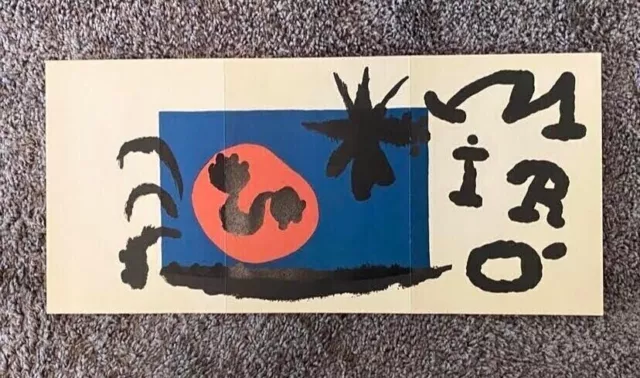
JOAN MIRO RARE 1959 Original Lithograph Exhibition Art Print Poster Venezuela
$1,799.99 Buy It Now 27d 22h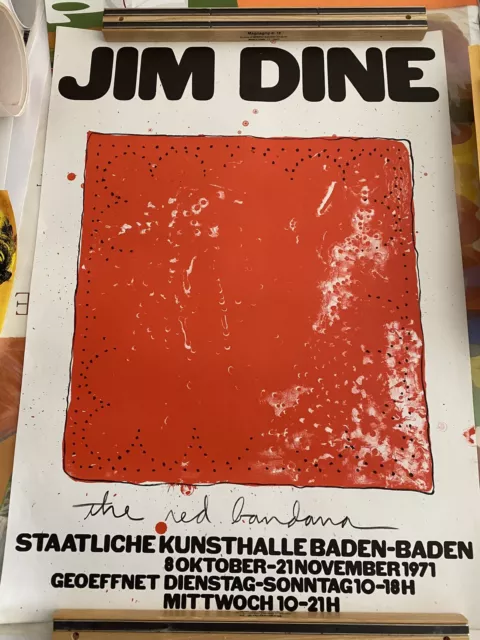
JIM DINE 1971 RARE ORIGINAL VINTAGE German Art Exhibition Poster
$149.00 Buy It Now 17d 1h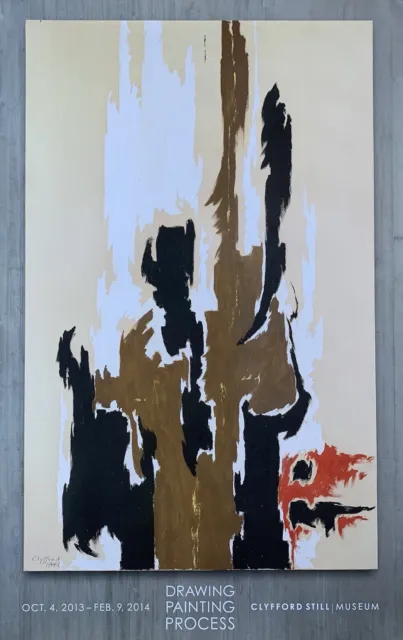
CLYFFORD STILL ABSTRACT EXPRESSIONIST EXHIBITION POSTER Of Painting PH-23
$99.99 Buy It Now 16d 1h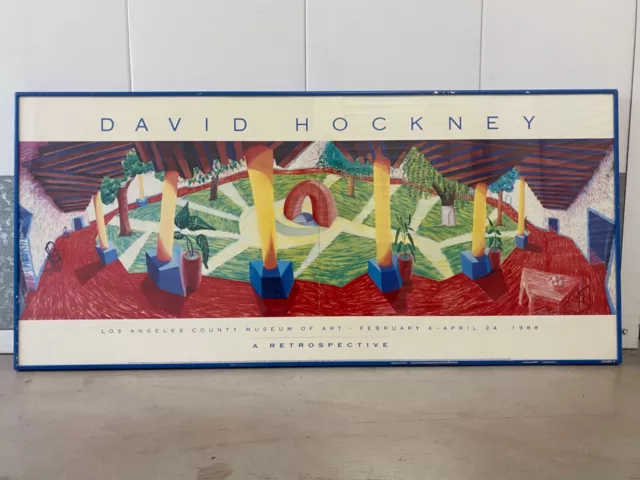
🔥 RARE Vintage David Hockney Modern LACMA Exhibition Lithograph Poster, 1988
$1,350.00 Buy It Now 21d 1h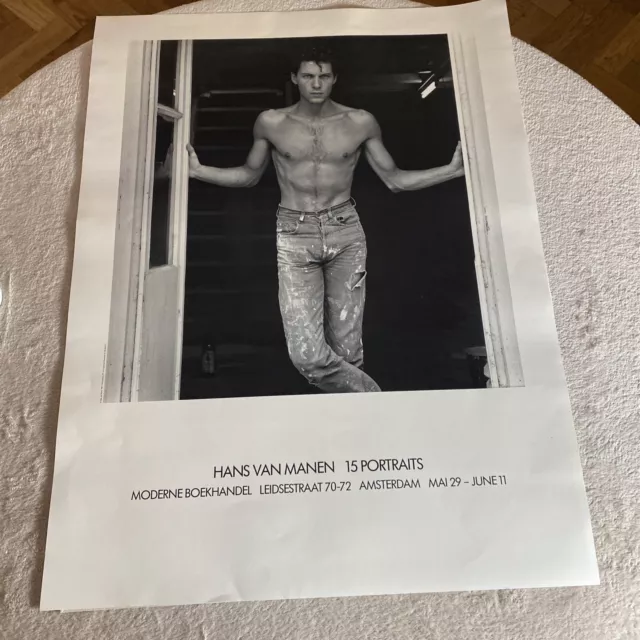
Vintage Original HANS VAN MANEN 15 Portraits Exhibition Poster Amsterdam 1983
$62.74 Buy It Now 22d 21h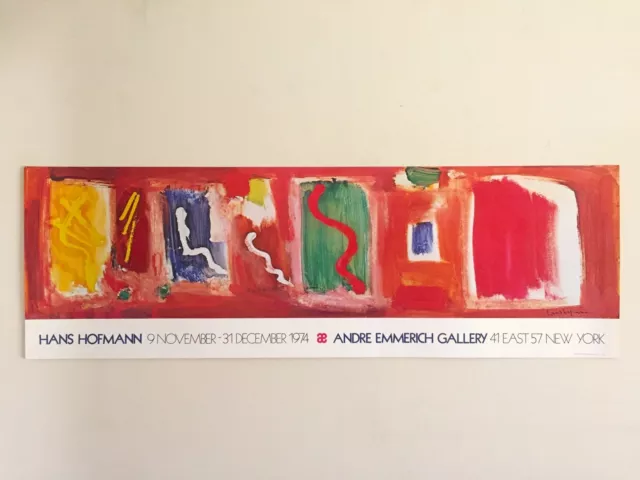
Hans Hofmann Rare 1974 Abstract Expressionist Lithograph Print Exhibition Poster
$2,250.00 Buy It Now 10d 6h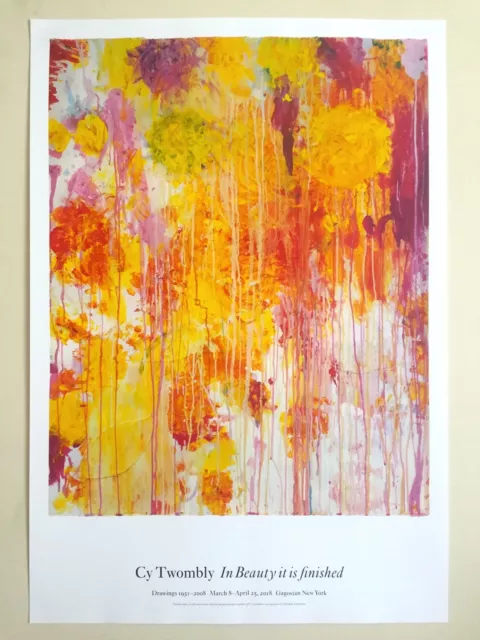
Cy Twombly Rare Abstract Expressionist Lithograph Print Exhibition Poster
$1,850.00 Buy It Now 6d 21h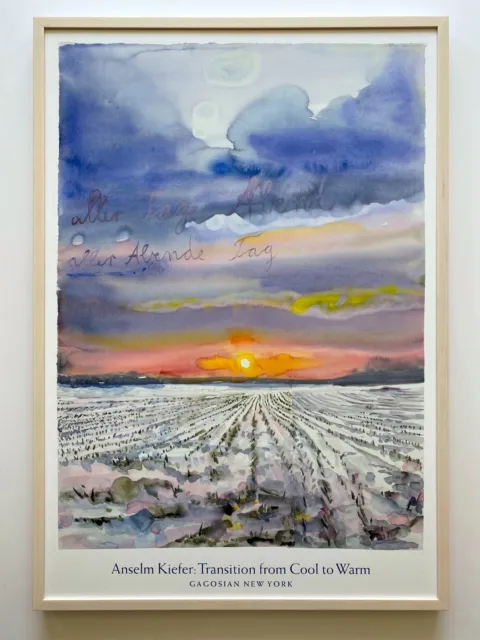
Anselm Kiefer Rare Expressionist Lithograph Print Framed Large Exhibition Poster
$3,250.00 Buy It Now 26d 19h
Joseph Zirker Exhibition Poster - Modern Abstract Expressionist Cubist Vintage
$195.00 Buy It Now 28d 13h
Vintage 1974 Hans Hofmann Andre Emmerich Gallery NY Exhibition Poster RARE!
$375.00 Buy It Now 12d 21h
Theo Tobiasse Modern Art Exhibition Lithograph Poster Old Vintage Expressionist
$299.00 Buy It Now 17d 1h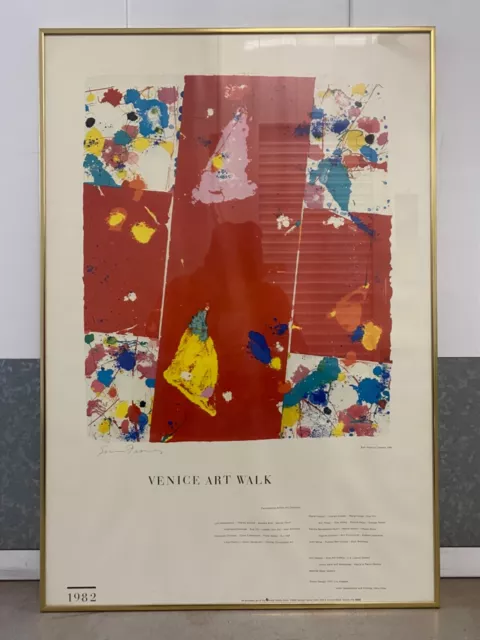
🔥 RARE Vintage Modern Venice Art Walk Signed Exhibition Poster, SAM FRANCIS '82
$2,750.00 Buy It Now 1d 6h
🔥 Vintage Modern Art JASPER JOHNS Drawings Los Angeles Exhibition Poster, 1981
$975.00 Buy It Now 21d 3h
Fabigan Wien Violin Waltz Music Austria Ostereich Vintage Poster
$1,790.00 Buy It Now 29d 5h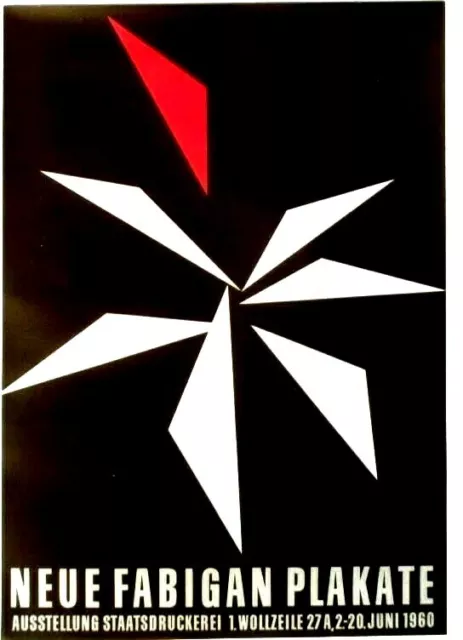
Original vintage poster PLAKATE FABIGAN POSTER EXPO 1960
$80.00 Buy It Now 25d 3h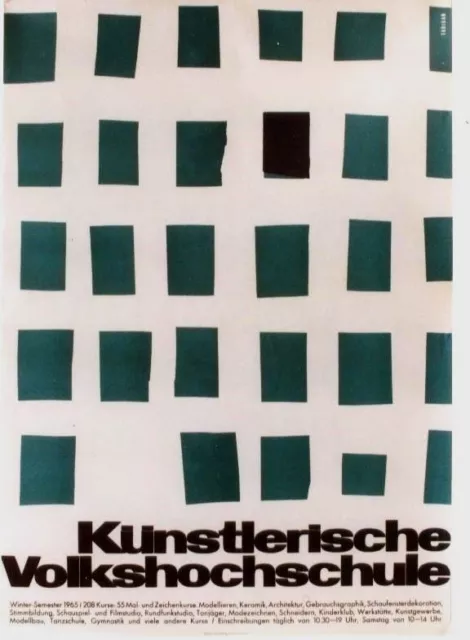
Original vintage poster VIENNA FINE ART SCHOOL 1965 Fabigan
$90.00 Buy It Now 23d 18h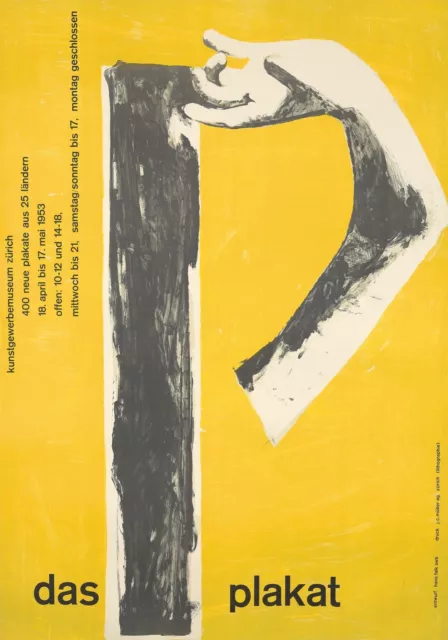
Original Vintage Poster Hans Falk Das Plakat Exhibition Zurich Museum 1953
$650.00 Buy It Now 23d 17h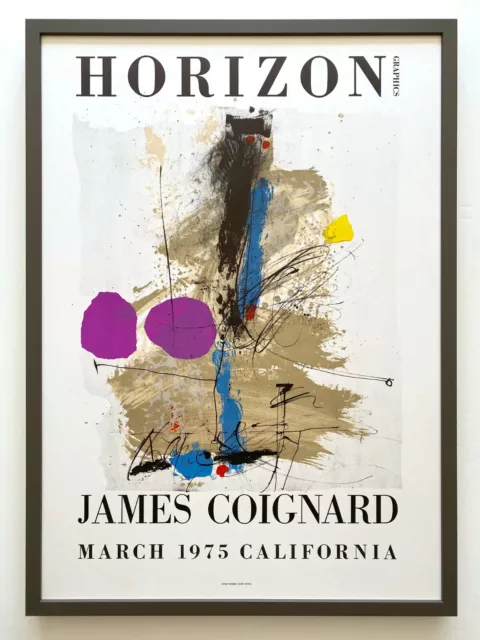
James Coignard Rare 1975 Abstract Expressionist Litho Print Framed Exhbtn Poster
$2,850.00 Buy It Now 9d 20h
Helen Frankenthaler Rare 1988 Abstract Expressionist Litho Print Exhbt Poster
$1,850.00 Buy It Now 7d 7h
Original vintage poster VIENNA FINE ART SCHOOL 1965 Fabigan
$120.00 Buy It Now 29d 3h
1978 RARE Hans Van De BOVENKAMP Exhibition POSTER Abstract SCULPTURE Modern ART
$75.00 Buy It Now 15d 9h
Rare Vintage Hans Hofmann 1974 Lithograph Print Abstract Exhibition Poster
$250.00 Buy It Now 13d 22h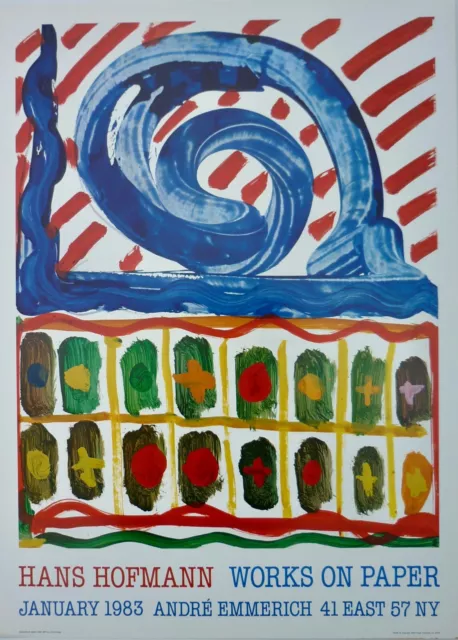
Vintage 1983 Hans Hofmann Andre Emmerich NY Exhibition Poster
$225.00 Buy It Now 12d 21h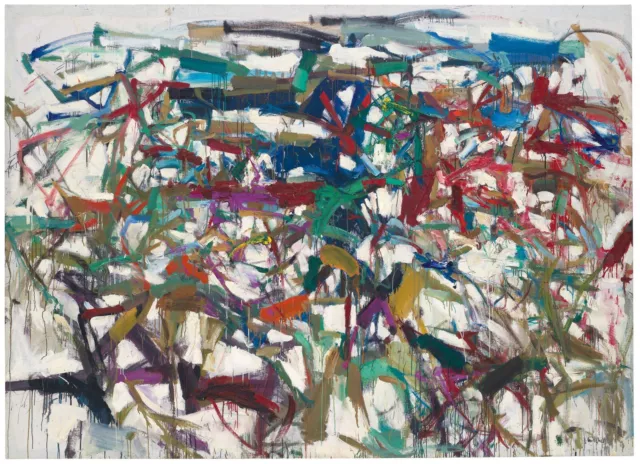
JOAN MITCHELL 'Ladybug', 1957 Abstract Expressionist Art Poster 27" x 33" *NEW*
$125.00 Buy It Now 23d 1h
Original vintage poster VIENNA FINE ART SCHOOL 1965 Fabigan
$90.00 Buy It Now 29d 3h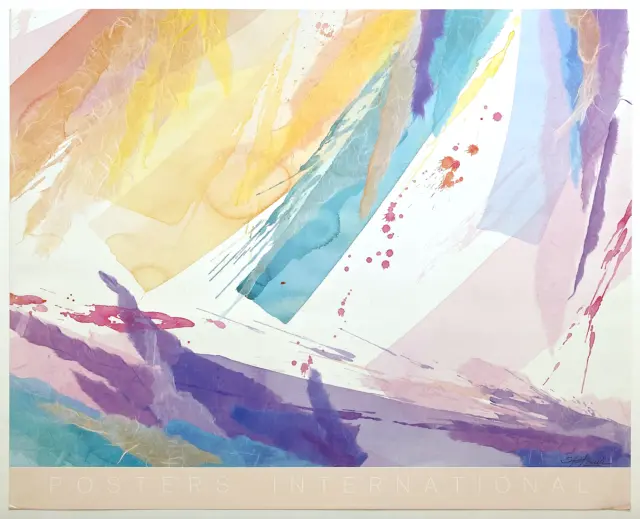
Vintage 1980'S Rare Post Modern Lithograph Print Abstract Expressionist Poster
$390.00 Buy It Now 25d 6h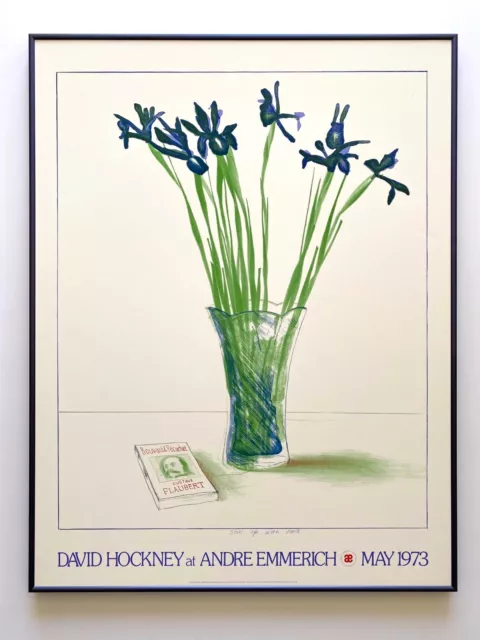
David Hockney Rare Vintage 1973 Lithograph Print Framed Iconic Exhibition Poster
$5,800.00 Buy It Now 17d 6h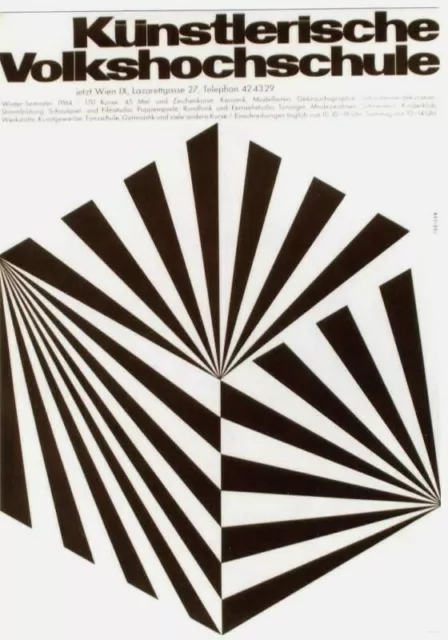
Original vintage poster VIENNA FINE ART SCHOOL 1964 Fabigan
$90.00 Buy It Now 10d 4h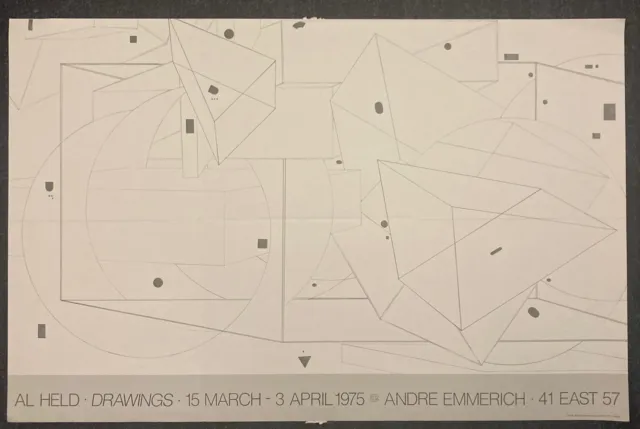
Al Held Drawings 15 March – 3 April 1975 Exhibition Poster Andre Emmerich (NYC)
$105.00 Buy It Now 5d 21h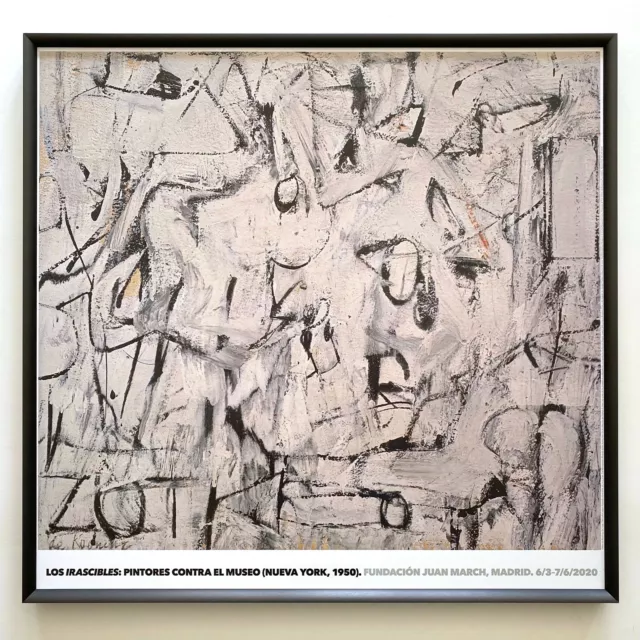
Willem De Kooning Foundation Abstract Expressionist Framed Exhbt Poster Zot 1949
$1,850.00 Buy It Now 21d 22h 7 watchers
7 watchersAUGUST MACKE german expressionist VINTAGE ART POSTER orphic cubism 20x30
$9.99 Buy It Now
august macke GERMAN EXPRESSIONIST self portrait VINTAGE ART POSTER 20x30 new
$9.99 Buy It Now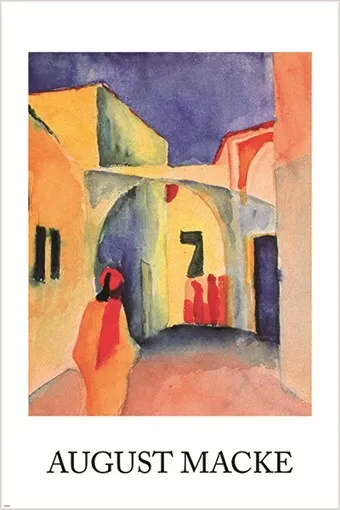 1 watcher
1 watcherORPHIC CUBISM august macke VIEW INTO A LANE 1914 german expressionist 20x30
$9.99 Buy It Now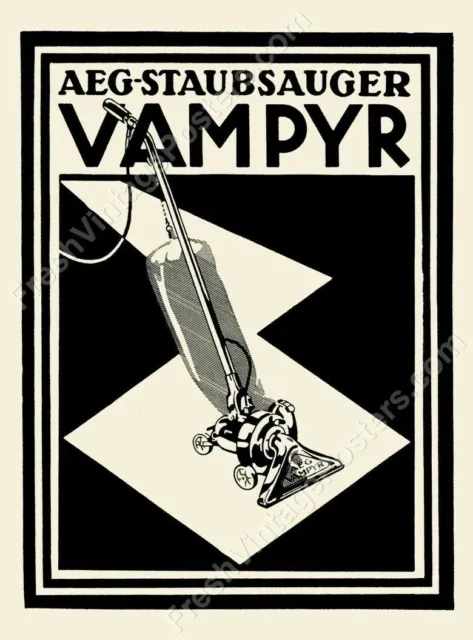
 Vampyr vacuum cleaner vampire 1925 German Expressionist art NEW poster 18x24
Vampyr vacuum cleaner vampire 1925 German Expressionist art NEW poster 18x24$25.00$21.25 Buy It Now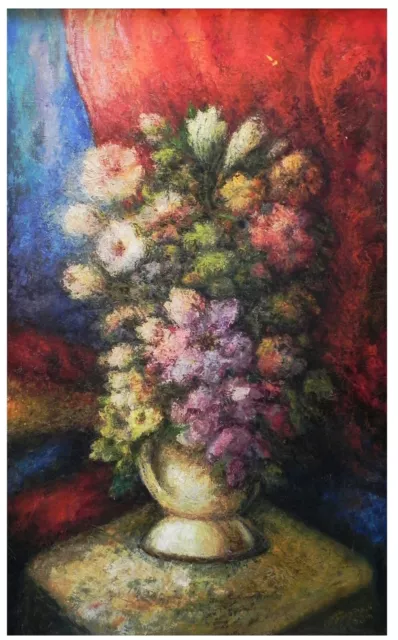 1 watcher
1 watcherShlomo Itzkowitch: Flower Vase 1968/ Israeli Jewish Polish German Expressionism
$680.00 Buy It Now or Best Offer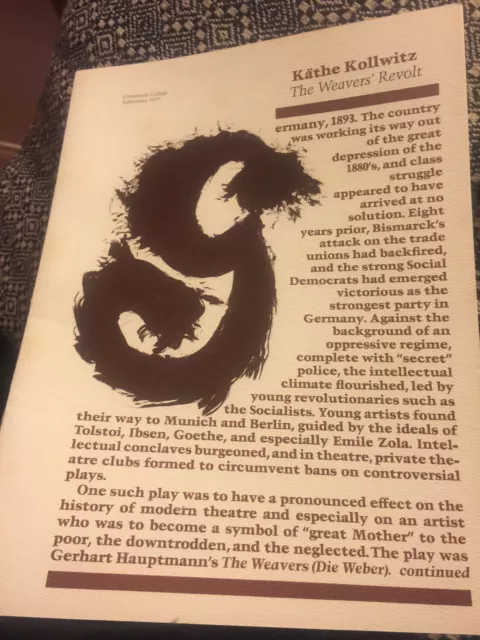 3 watchers
3 watchers1977 VINTAGE KATHE KOLLWITZ ETCHING Exhibition Catalog GERMAN EXPRESSIONIST
$29.99 Buy It Now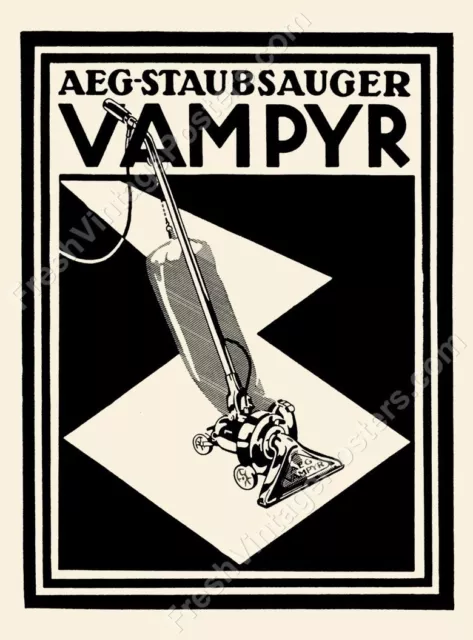 1 watcher
1 watcher Vampyr vacuum cleaner vampire 1925 German Expressionist NEW fine art print 24x32
Vampyr vacuum cleaner vampire 1925 German Expressionist NEW fine art print 24x32$40.00$34.00 Buy It Now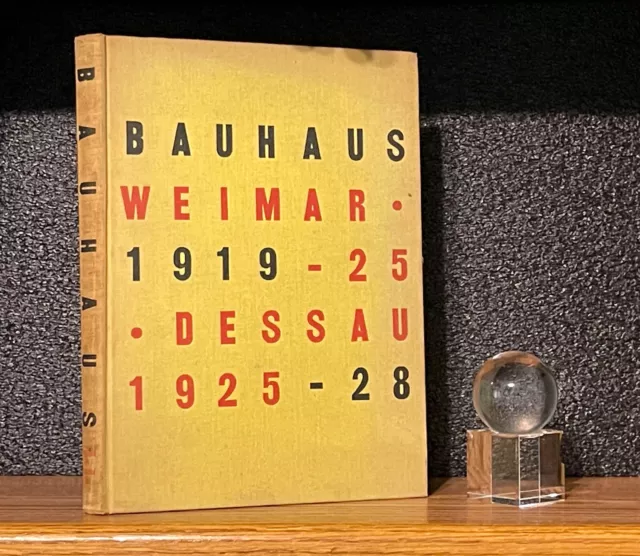 13 watchers
13 watchersBauhaus 1919-1928 MoMA Museum of Modern Art exhibition 1st 1938 Klee Kandinsky!!
$450.00 Buy It Now or Best Offer
Large Decadence & Decay Expressionist Wall Art Print by Beckmann, Dix, Grosz VTG
$140.00 Buy It Now or Best Offer
